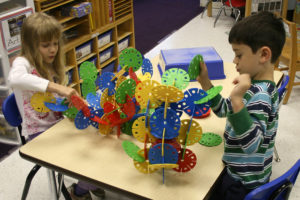Over the past four years, I have been teaching in a Kindergarten classroom. When I first started, I was guided by a draft of the new BC Curriculum (B.C. Ministry of Education, 2018) plus the mentorship of the other Kindergarten teacher at my school and the principal. The word “play” and its variations appear in the Kindergarten document less than ten times. Consequently, my concept of Kindergarten play came from my mentors. Recently, my district has been promoting play in the primary grades, but with the emergence of the COVID-19 crisis, efforts have stalled. My District Teacher Leader for Early Literacy and Learning mentioned that she was excited about the new Play Today B.C. Handbook (BC Ministry of Education, 2019) so I am happy I was able to make the time to read it. In addition, I found two articles to examine alongside the BC Curriculum. These readings brought clarity to my thinking around play and play-based learning.
In the article, A Scoping Review of Research on PlayBased Pedagogies in Kindergarten Education, Pyle, DeLuca, and Danniels (2017) determined that research on play in schools is divided into two types, free, or child-directed, play and teacher-directed play. They recognized the two types could be combined into mutually-directed play, led by children and teachers cooperatively (Pyle et al., 2017). They found that while most teachers agreed that free play is important for social-emotional development, many struggled with the value and efficiency of play for teaching academics.
Teachers expressed concern about time and the academic pressures of curriculum, parents, and teacher colleagues (Pyle et al., 2017). I shared these concerns. Though I know that our curriculum and district are now promoting more play-based approaches, I also know that my grade one teacher colleagues have certain expectations for their incoming learners. Also, I feel pressure from other kindergarten teachers in my school who use didactic methods. Consequently, I often fall back into traditional methods of instruction, reducing play time. Pyle et al. (2017) conclude that researchers focused on free play found positive connections with cognitive, social-emotional, and self-regulatory skills, while researchers focused on teacher and mutually-directed play found positive connections with numeracy, literacy, and other academic skills. They add that researchers and educators need to move toward the integrated concept a continuum of play.
Curious about the continuum of play, I explored, A Continuum of Play-Based Learning: The Role of the Teacher in Play-Based Pedagogy and the Fear of Hijacking Play (Pyle & Danniels, 2017). This article defined five categories: free play, inquiry play, collaboratively designed play, playful learning, and learning through games. It placed them on a continuum from child-directed to teacher-directed.
The article provided some concrete examples of each category of play which allowed me to see that my own practise has already begun to change. I have always used large chunks of free play time and employed some learning games. I am continuing to build my repertoire of learning games and playful learning activities. Inquiry play and collaboratively designed play are more challenging as they require new skills and making more room in our day. As I increase learning games and playful learning strategies, I hope to spend less time helping dysregulated learners to catch up on academics during play time. The only challenge left would be overcoming my compulsion to keep all the adults happy.
Convincing parents, guardians, and my teaching colleagues that increasing play time in its various forms is best practise for kindergarten, and beyond, will be easier now that the education ministry has published the Play Today B.C. Handbook (BC Ministry of Education, 2019). It cites a variety of research to support its statement, “Play-based learning opportunities in primary grades challenge children and contribute to strong communication, critical thinking, ability to make friends, take responsibility, collaborate, persist, investigate, solve problems, innovate, acquire reading, writing, numeracy and digital literacy skills, and cross-cultural understanding” (BC Ministry of Education, 2019, p.22). The handbook contributes to educators’ understanding of play by describing four categories: functional play, constructive play, dramatic play, and games with rules. It adopts the continuum put forth by Pyle and Danniels (2017). The handbook provides examples that help define the educator’s role. With this ministry-supported document, I feel I have something to point to when questioned by adults regarding my practise.
These readings are important to curriculum because they supplement the specifics of what to teach, the Big Ideas and Learning Standards, from the B.C. Curriculum (B.C. Ministry of Education, 2018) with ideals about how to teach it and why. It helps define my role in play-based learning. Whether these ideals and definitions should be included in the curriculum itself is a question of teacher autonomy and access. Including them might affect teachers’ abilities to decide their methods. If excluded, teachers may not assess or access them at all. If memory serves, the old B.C. curriculum included suggestions linked to learning outcomes. This may be a wise approach for implementing play-based learning strategies in the new curriculum. Because they are suggestions, autonomy would be protected, but teachers who wish to embrace play can find concrete ideas to begin building play into their practise. Should the rationale for play be included in the curriculum document? I think that there could be a link to the rationale in the document, but I still believe that promoting the rationale should fall to ministry, district or administrator-initiated professional development. After all, the switch to play-based learning is not simply a concern for Kindergarten but for all primary grade teachers and beyond. It should not be the responsibility of one keen teacher to sell a new doctrine to an entire staff.

Recent Comments